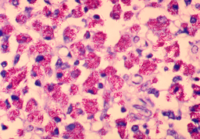
Photo of man in shower courtesy of Ville Miettinen
Taking a shower, especially those with plastic shower head, may cause lung diseases according to findings published in Proceedings of the National Academy of Science by researchers led by Professor Norman Pace titled Opportunistic pathogens enriched in showerhead biofilms. The findings that a biofilm containing Mycobacterium avium may grow and cling to the inside of shower head, especially plastic shower head.
This finding may explain why there is an increase in lung infections in this era where more people take showers rather than baths. As water spurt from shower heads, tiny water droplets containing the bacteria get suspended in the air and inhaled deep into the lungs, causing lung diseases. While rarely a problem for healthy people, those with weakened immune systems such as the elderly, pregnant women or those weakened by other diseases may get their lungs infected with M. avium and fall sick.
In addition to M. avium, showers may also spread a type of pneumonia called Legionnaires' disease which is caused by a bacterium Pseudomonas aeruginosa.
Mycobacterium avium
 Mycobacterium avium complex (MAC) is a group of genetically related bacteria belonging to the genus Mycobacterium. It includes Mycobacterium avium subspecies avium (MAA), Mycobacterium avium subspecies hominis (MAH), and Mycobacterium avium subspecies paratuberculosis (MAP).
Mycobacterium avium complex (MAC) is a group of genetically related bacteria belonging to the genus Mycobacterium. It includes Mycobacterium avium subspecies avium (MAA), Mycobacterium avium subspecies hominis (MAH), and Mycobacterium avium subspecies paratuberculosis (MAP).Historically, MAC has also included Mycobacterium avium intracellulare (MAI) – a distinct species of bacteria.
Source: Wikipedia: Mycobacterium avium complex
Pseudomonas aeruginosa
 Pseudomonas aeruginosa is a common bacterium which can cause disease in animals and humans. It is found in soil, water, skin flora and most man-made environments throughout the world. It thrives not only in normal atmospheres, but also with little oxygen, and has thus colonised many natural and artificial environments. It uses a wide range of organic material for food; in animals, the versatility enables the organism to infect damaged tissues or people with reduced immunity. The symptoms of such infections are generalised inflammation and sepsis. If such colonisations occur in critical body organs such as the lungs, the urinary tract, and kidneys, the results can be fatal.[1] Because it thrives on moist surfaces, this bacterium is also found on and in medical equipment including catheters, causing cross infections in hospitals and clinics. It is implicated in hot-tub rash.
Pseudomonas aeruginosa is a common bacterium which can cause disease in animals and humans. It is found in soil, water, skin flora and most man-made environments throughout the world. It thrives not only in normal atmospheres, but also with little oxygen, and has thus colonised many natural and artificial environments. It uses a wide range of organic material for food; in animals, the versatility enables the organism to infect damaged tissues or people with reduced immunity. The symptoms of such infections are generalised inflammation and sepsis. If such colonisations occur in critical body organs such as the lungs, the urinary tract, and kidneys, the results can be fatal.[1] Because it thrives on moist surfaces, this bacterium is also found on and in medical equipment including catheters, causing cross infections in hospitals and clinics. It is implicated in hot-tub rash.Source: Wikipedia: Pseudomonas aeruginosa
Legionnaires' disease
Legionellosis is an infectious disease caused by bacteria belonging to the genus Legionella.[1][2] Over 90% of legionellosis cases are caused by Legionella pneumophila, a ubiquitous aquatic organism that thrives in temperatures between 25 and 45 °C (77 and 113 °F), with an optimum around 35 °C (95 °F).[3]Legionellosis takes two distinct forms:
Legionnaires' disease, also known as "Legion Fever" (archaic), is the more severe form of the infection and produces pneumonia.
Pontiac fever is caused by the same bacterium, but produces a milder respiratory illness without pneumonia which resembles acute influenza.
Source: Wikipedia: Legionellosis
4 comments:
what's with the picture..i know i always shower with a tie on and with another man..
Yeah, I found that kind of odd myself!!!
other websites commented that this disease is common to those with weakened immune systems, such as with AIDS & HIV. Perhaps that is what is depicted by the picture, without having to specifically state it.
To the HIV/AIDS comment... that's an extremely uneducated statement. Congratulations on successfully oppressing the LGBT community. Staying on topic, this article may help us prevent immunocompromised (chemo patients, hiv/aids, etc) from contracting some illness.
Post a Comment